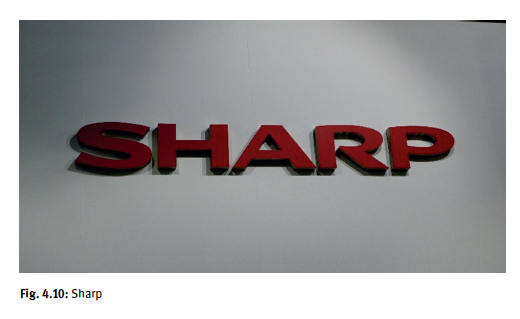
A milestone in the history of Sharp was its ambiguous strategic decision to start developing alternative display concepts for television set production that might replace the conventional cathode ray tube (CRT) technology. In 1986, the Japanese firm established liquid crystal display (LCD) laboratories within the corporate research and development group of the firm. Two years later, in 1988, Sharp developed the world’s first 14-inch color thin film transistor (TFT) LCD. In 1991, Sharp completed its construction of a TFT LCD plant in Tenri, Nara (Japan) and successfully launched the world’s first HDTV LCD projector and the world’s first wall-mounted LCD TV. At that time, the European market reached a sales volume of around 30 million units of cathode ray tube television sets, which was the dominating technology. Despite the mainstream of competitors, Sharp concentrated its major financial and research and development resources on the LCD technology. At the beginning of the 1990s, it was neither clear when CRT technology might be replaced nor whether the competing flat panel plasma technology might succeed in competing with LCD (Sharp 2007b). In 1994, Sharp announced the construction of the world’s largest TFT LCD plant in Taki, Mie Prefecture in Japan. Just one year later Sharp established Wuxi Sharp Electronic Components Co., Ltd. (WSEC), a joint company in China for the manufacture and sales of LCDs.
Why is the consistent and unflustered concentration on LCD technology by the management of Sharp, in fact, impressive? The investment decision was proactive but also very risky due to the nebulous market forecasts for the flat panel market development. For instance in Europe, a mass market for LCD TVs did not exist during the 1990s. Nevertheless, Sharp continued its R&D and manufacturing efforts. In 1999, Sharp launched the world’s first 20-inch LCD TV (Sharp 2007b). At this time, European manufacturers such as Thomson and Philips, for example, continued to manufacture television sets based on the obsolete cathode ray tube technology. Thanks to its technological capacities, Sharp was much more advanced at that time than its competitors, such as Sony, Samsung and others. Sharp secured a favorable market position for the coming years.
Instead of serving consumer electronics mass markets with a broad range of products, Sharp preferred to concentrate on markets which are based on advanced display technology expertise, energy saving, electric and electronic components. The strategic concept of Sharp significantly differed from its Korean rival Samsung.
At the beginning of the 21st century, Sharp continued efforts to expand its research and development as well as its manufacturing capacities of technologically advanced displays. (Sharp 2007a, 2008). At that time, Sharp’s factory was the world’s first vertically integrated production facility, carrying out the complete range, from manufacturing LCD panels to the final assembly of television sets. The fusion of liquid crystal technologies and television audio-visual technologies has resulted in high-quality LCD television sets and has accelerated the transition from cathode ray tubes to LCDs in the global markets (Sharp 2008).
Sharp aimed to become an innovative pioneer also for solar cells, used for alternative energy generation (solar cells manufacturing has similarities with LCD display manufacturing). However, despite all its efforts, Sharp continued facing drawbacks in creating as reputable and powerful an image abroad as they have in their home country of Japan. Obviously, the marketing and communication policy outside Japan needed to be better adjusted according to the behavioral attitudes of Western customers, such as in Europe.
In parallel, Sharp failed to successfully enter newly upcoming business fields such as smartphones, tablets, and navigation systems where the Japanese firm could use their own LCD technology, combining their product portfolio (Tabuchi 2012). At the same time, global competition in the solar module segment became intense which caused solar photovoltaic manufacturers to reduce their orders to Sharp or even declare bankruptcy (Bilby 2013; Chaffin 2013; SolarOne 2010). All in all, the solar photovoltaic business developed far below expectations for Sharp. As a result, during the period between 2012 and 2015 Sharp accumulated losses of more than USD 10 billion and the outlook for the future was pessimistic (Sharp 2013, 2018).
In August 2015, Sharp started negotiating with Foxconn (Hon Hai Precision Industry), seeking to transfer its LCD display panel business into an international joint venture. However, instead of a joint venture, a major part of the former Japanese innovative flagship company was taken over. In 2016, against the payment of USD 3.81 billion Foxconn received 66 percent of shares becoming majority owner of Sharp (Mochizuki 2016; Sharp 2016).
Source: Glowik Mario (2020), Market entry strategies: Internationalization theories, concepts and cases, De Gruyter Oldenbourg; 3rd edition.

Enjoyed looking through this, very good stuff, regards.
Its like you learn my thoughts! You seem to know so much approximately this, like you wrote the e-book in it or something. I think that you simply can do with a few p.c. to power the message home a little bit, but instead of that, that is great blog. An excellent read. I’ll definitely be back.